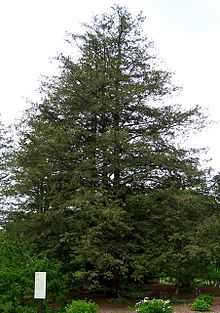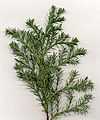Chamaecyparis pisifera
| Chamaecyparis pisifera | |
|---|---|
 | |
| Chamaecyparis pisifera Morton Arboretum acc. 745-27*4 | |
| Conservation status | |
| Scientific classification | |
| Kingdom: | Plantae |
| Division: | Pinophyta |
| Class: | Pinopsida |
| Order: | Pinales |
| Family: | Cupressaceae |
| Genus: | Chamaecyparis |
| Species: | C. pisifera |
| Binomial name | |
| Chamaecyparis pisifera (Siebold & Zucc.) Endl. | |
Chamaecyparis pisifera (Sawara Cypress or Sawara Japanese: サワラ Sawara) is a species of false cypress, native to central and southern Japan, on the islands of Honshū and Kyūshū.[1][2]
It is a slow-growing coniferous tree growing to 35–50 m tall with a trunk up to 2 m in diameter. The bark is red-brown, vertically fissured and with a stringy texture. The foliage is arranged in flat sprays; adult leaves are scale-like, 1.5–2 mm long, with pointed tips (unlike the blunt tips of the leaves of the related Chamaecyparis obtusa (Hinoki Cypress), green above, green below with a white stomatal band at the base of each scale-leaf; they are arranged in opposite decussate pairs on the shoots. The juvenile leaves, found on young seedlings, are needle-like, 4–8 mm long, soft and glaucous bluish-green. The cones are globose, 4–8 mm diameter, with 6–10 scales arranged in opposite pairs, maturing in autumn about 7–8 months after pollination.[1]
A related cypress found on Taiwan, Chamaecyparis formosensis (Formosan Cypress), differs in longer ovoid cones 6–10 mm long with 10–16 scales.[1] The extinct Eocene species Chamaecyparis eureka, known from fossils found on Axel Heiberg Island in Canada, is noted to be very similar to C. pisifera.[3]
Uses
It is grown for its timber in Japan, where it is used as a material for building palaces, temples, shrines and baths, and making coffins, though less valued than the timber of C. obtusa. The wood is lemon-scented and light-colored with a rich, straight grain, and is rot resistant.[4]
It is also a popular ornamental tree in parks and gardens, both in Japan and elsewhere in temperate climates including western Europe and parts of North America. A large number of cultivars have been selected for garden planting, including dwarf forms, forms with yellow or blue-green leaves, and forms retaining the juvenile needle-like foliage; particularly popular juvenile foliage cultivars include 'Plumosa', 'Squarrosa' and 'Boulevard'.[4]
References
- ↑ 1.0 1.1 1.2 Farjon, A. (2005). Monograph of Cupressaceae and Sciadopitys. Royal Botanic Gardens, Kew. ISBN 1-84246-068-4
- ↑ Conifer Specialist Group (1998). Chamaecyparis pisifera. 2006. IUCN Red List of Threatened Species. IUCN 2006. www.iucnredlist.org. Retrieved on 12 May 2006.
- ↑ Kotyk, M.E.A.; Basinger, J.F.; McIlver, E.E. (2003). "Early Tertiary Chamaecyparis Spach from Axel Heiberg Island, Canadian High Arctic". Canadian Journal of Botany 81: 113–130. doi:10.1139/B03-007.
- ↑ 4.0 4.1 Dallimore, W., & Jackson, A. B. (1966). A Handbook of Coniferae and Ginkgoaceae 4th ed. Arnold.
-

Foliage and cones
-

Central trunk of a tree
-

Bark
-
Bonsai example
-

Foliage of the juvenile cultivar 'Boulevard', with soft feathery needle-like leaves
-
Cultivar 'Golden Charm'
| Wikimedia Commons has media related to Chamaecyparis pisifera. |


